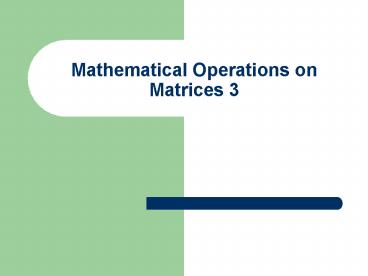Mathematical Operations on Matrices 3 - PowerPoint PPT Presentation
1 / 13
Title:
Mathematical Operations on Matrices 3
Description:
This section will aim to build on the work done in the previous two sections, by ... If A and B are two square matrices such that the following is true: AB=I. ... – PowerPoint PPT presentation
Number of Views:243
Avg rating:3.0/5.0
Title: Mathematical Operations on Matrices 3
1
Mathematical Operations on Matrices 3
2
The Inverse of a Matrix
- This section will aim to build on the work done
in the previous two sections, by moving on to a
more complicated problem, that of using the
inverse of a matrix. - Unfortunately division of a matrix by another
matrix is not possible per se. - An alternative to division is the multiplication
of a matrix by its inverse. - So, what is the inverse of a matrix?
3
The Inverse of a Matrix 2
- We can define the inverse of a matrix in the
following way - If A and B are two square matrices such that the
following is true ABI. - Where I is the Identity matrix (as you will
recall from the first section) - Then B is the inverse of A, and is often denoted
as A-1 - So, how can we define the inverse of a given
matrix?
4
The Inverse of a Matrix 3
- The inverse of a two by two matrix is given by
the following - a b-1 1 0d -b c
d ad-bc -c a - If matrix A is of the form a b then (ad-bc) is
called the determinant of A. c d - The determinant of A be written in the following
ways det(A) or A or deta b or a
b c d c d
5
Determinants 1
- The determinant of A is very useful, because it
can indicate whether or not the A has an inverse. - How does this work?
- Well, if detA is equal to 0 (zero) then the
matrix A has no inverse. This is because of the
formula shown below would involve dividing by 0.
This is a mathematically unpleasant area, and is
not a defined operation. - a b-1 1 0d -b c
d ad-bc -c a - If a matrix A has no inverse, then it is said to
be singular.
6
Determinants 2
- You can work out the determinant of A by
multiplying diagonally across elements a b
c d and then subtracting the
resulting products. - This gives you detA (ad)-(bc)
- Next we shall try a practical example.
7
Determinants 3
- Suppose we have the following matrix B 2
7 3 5 - The determinant of B is obtained by multiplying
diagonally across elements, and then subtracting
the product - detB 2 7 (2x5)-(7x3) 3
5 - detB 10 21 -11
- Do you understand how this works?
8
The Inverse of a Matrix 4
- So, now that we understand how to find the
determinant of a matrix, how does that help us
with finding the inverse of the matrix? - As stated, the inverse of matrix A is given
by a b-1 1 0d -b c
d ad-bc -c a - So the inverse has been obtained by swapping the
positions of a and d, changing the signs of b and
c, and dividing the whole by the determinant of
A. - Shall we try an example?
9
The Inverse of a Matrix 5
- As stated, the inverse of matrix A is given
by a b-1 1 0d -b c
d ad-bc -c a - Let us find the inverse of matrix B 2
7 3 5 - We have already found the determinant of B, which
was obtained by multiplying diagonally across
elements, and then subtracting the product. detB
-11 - Therefore the inverse of B is 1 05
-7 -11 -3 2
10
The Inverse of a Matrix 6
- Given B 2 7 3 5
and B-1 1 05 -7 -11 -3 2 - We can show that BB-1 I
- Try to work this out for yourself. We shall talk
you through it on the next slide.
11
The Inverse of a Matrix 7
- Given B 2 7 3 5
and B-1 1 05 -7 -11 -3
2 Show that BB-1 I - BB-1 2 7 1 05 -7 1
0(2x5)(3x-7) (7x5)(5x-7) 3 5 -11
-3 2 -11 (2x-3)(3x2) (7x-3)(5x2) - BB-1 1 0(10)(-21) (35)(-35) 1
0-11 0 -11 (-6)(6) (-21)(10)
-11 0 -11 - BB-1 1 0-11 0 1 0 -11 0
-11 0 1
12
Exercise 4 See Answers.ppt
- A 2 4 B 1 8 C 3 8 D 1 2
4 5 1 8 2 5
0 2 - Find the determinants of the above matrices.
- Find the inverse matrix of each of the above
matrices.
13
Summary
- In this section you have learnt how to find the
inverse of 2x2 matrices, and also how to
calculate the determinant of a given 2x2 matrix. - You can now choose whether of not you wish to
expand you knowledge of matrices with the
additional option Algebra with Matrices, or
else, if you wish, you can spend some extra time
reading through the recommended texts to broaden
your knowledge of this subject area. - Make sure that you are satisfied with the work in
this section before moving on to any further
study.































